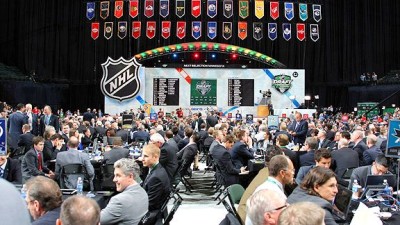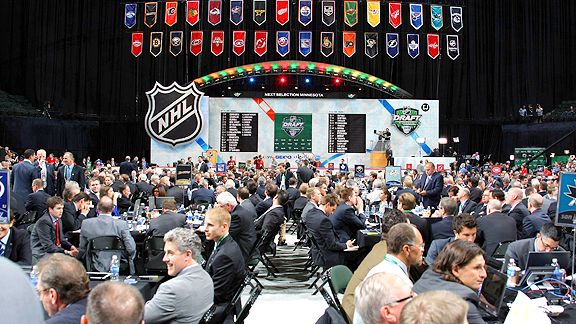
2015 NHL Draft Floor
As the 2015 NHL Entry Draft quickly approaches us, we look more into draft theory and discuss processes that allow one to maximize their success.
Most draft services open to the public will discuss two factors in a prospect: risk and reward.
The higher a player’s ceiling, the more potential reward a prospect has. While sometimes this varies, for the most part public third party scouting services agree on upside with each other, the numbers, and how players historically turn out.
There does seem to be an inefficiency though, and that is in determining risk. The more one immerses themselves in draft analytics the more one discovers that their is a flaw in risk assessment.
Here are two players familiar to Winnipeg Jets fans to represent this difference.
In 2013, Kevin Cheveldayoff and the Winnipeg Jets drafted Joshua Morrissey 13th overall. The left-hand shot defender had been ranked by most public draft services in the mid-first round. The scouting notes described Morrissey as a dynamic skater, who struggles defensively and his size will be a hurdle he would have to try and overcome. Morrissey’s size was listed between 5’11 and 6’0 depending on the location.
Morrissey was a strong scorer, who had already posted 85 points in 138 games in the WHL prior to being drafted.
Four months later the Jets picked up Keaton Ellerby on waivers from the Los Angeles Kings.
For those that do not know, Ellerby was once considered a high end draft prospect. Final draft rankings had Ellerby as one the top defensemen in the draft. CS had him #1 for NA defensemen. ISS had him ranked #2 for defensemen, as did The Hockey News. McKeen’s final ranking had the worst ranking, placing Ellerby as the 3rd best defensman of the 2007 draft. In the end Ellerby was drafted 10th overall.
The main reason was size. Ellerby was a 6’4 defender who could skate very well for his size. His point production was not terrible by any measure, but 33 points in 137 WHL games prior to the draft places him at a clear level below Morrissey.
Now Ellerby is not a failed draft pick. He has already played 212 games in the NHL, which is just over the 200 NHL game threshold many use to evaluate those that did succeed in making the NHL.
Still, Ellerby and Morrissey make good examples of where the flaw is with evaluating risk of draft picks.
Going into the draft, many thought that Ellerby had an impressive ceiling, but many were unsure if he would ever reach it. He was well thought of however as a low-risk draft selection due to his size.
This is the common thought process. Bigger players can play lower depth roles if they do not reach top-4 defender or top-6/9 forward potential. Smaller players though do not have that safety. This means there are more potential spots for a larger player, which means less risk.
This is partly true. The issue is that it is only partly true.
Now obviously the situation varies individually from person to person, but there is a trend that the better overall player is the safer player.
Using the newly developed The Projection Project application, we can look at drafted players who scored similarly to Morrissey and Ellerby and were within two inches in height. I also filtered for draft picks in the first three rounds.

CKM Sports’ Hockey Analysis: Comparing Ceiling and Probability
As you can see, the numbers seem to fit the idea that a player with Keaton Ellerby’s size and scoring can fill a depth role better than a player with similar size and numbers to Joshua Morrissey. However, this does not make Ellerby-types the safer pick.
Expanding outside of exclusively the first three rounds and we see a stark difference in success rates.
Joshua Morrissey Draft Cohorts

CKM Sports’ Hockey Analysis: Level of Draft Success
Keaton Ellerby Draft Cohorts

CKM Sports’ Hockey Analysis: Level of Draft Success
Charts are courtesy of The Projection Project.
This is not news to the analytical community. Rhys Jessop, now of Canucks Army fame, long ago showedthat higher scorers succeed in making the NHL more often even for defensemen.
Now take caution in making the wrong assumption. This does not mean that a higher scoring small player is automatically safer pick than a larger player who does not score as effectively.
Size matters in hockey. There is a positive relationship in successfully making the NHL and height(although not really much for weight). If it were not for Ellerby’s 6’4 frame, he probably would not have been effective enough to have the career he had.
It’s a more complex reality than just simply more scoring equates to a better prospect.
Many have seen 2015 draft eligible Oliver Kylington falter through the draft ranks, with scouts questioning if Kylington is a boom or bust draft pick. Some are even placing Thomas Chabot (who is a really good prospect) as the less risky player due to his size and ability to play a depth role if he doesn’t hit his ceiling.
Still, Josh Weissbock and Money Puck’s draft cohort system has found over 50 percent success rates for players like Kylington, while Chabot-type players sit around 21 percent success rate.
It’s not simply due to scoring levels. The short in stature Mitchel Vande Sompel cohorts only succeed at about a 20 percent rate, even though Vande Sompel has nearly doubled Chabot’s scoring.
Traditionally determining ceiling and upside has been a highly effective process. The draft market has been relatively efficient in that area. However, it still seems that without statistics it becomes much more difficult to get an accurate handle on how much risk a player presents.- Garret Hohl
